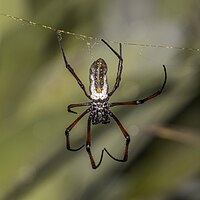
Photo from wikipedia
The use of regular wound dressings commonly brings about excessively retained wound exudate between the dressing and the wound, which is detrimental to the healing. This study manages to control… Click to show full abstract
The use of regular wound dressings commonly brings about excessively retained wound exudate between the dressing and the wound, which is detrimental to the healing. This study manages to control the biofluid around wounds effectively. To begin with, silk fibroin (SF) is extracted from silk. Next, SF and PCL are mixed and electrospun into multiscale hydrophobic nanofibers on the surface of the dopamine (PDA)-treated hydrophilic PVA nanofibrous membranes, thereby forming asymmetric wetability composite membranes with one-way water conduction. Moreover, PVA nanofibrous membranes are immersed in a PDA solution with an attempt to have a greater surface chemical activity and thus demonstrate an 85% greater wicking height and an air permeability being 90 mm/s. A 20% (w/v) SF solution and an 8% (w/v) PCL solution with a feeding rate being 1:3 provide the resulting SF/PCL nanofibrous membranes with greater hydrophobic properties, namely a water contact angle being 112°. In addition, the ultimate asymmetric wetability composite membranes exhibit an excellent wetting gradient, which benefits the directional transmission of moisture. The moisture management test results indicate that when the electrospinning time for PVA and SF/PCL layers is separately 30 min and 5 min, the resulting composite membranes attain the effect of one-way water conduction. In vitro analysis confirmed that the composite membrane produced were non-toxic. This unique wound dressing with one-way water conduction has a giant potential to serve as new type wound dressings for clinical use.
Journal Title: Journal of Materials Science
Year Published: 2020
Link to full text (if available)
Share on Social Media: Sign Up to like & get
recommendations!